| In this use case, we present
rules interchange between the Semantic Web Rule
Language along with the Web Ontology Language
(SWRL/OWL) and the Object Constraint Language
along with the UML (UML/OCL). The solution is
based on the REWERSE I1 Rule Markup Language (R2ML),
a MOF-defined general rule language, as a pivotal
metamodel and the bidirectional transformations
between SWRL/OWL and R2ML and between OCL/UML
and R2ML. We use the Rule Definition Metamodel
(RDM) as metamodel for the SWRL language, that
is based on the Ontology Definition Metamodel
(ODM).
OCL is a language
that enables one to describe expressions and constraints
on object-oriented (UML and MOF) models and other
object modeling artifacts. An expression is an
indication or specification of a value. A constraint
is a restriction on one or more values of (part
of) an object-oriented model or system. The OCL
metamodel inerhits the UML metamodel. The UML
is the most used and known language to model application
structure, behaviour and architecture but also
business process and data structure. Since the
standard specification of the OCL metamodel [1]
does not contains support for OCL invariants,
in our research, we introduced the EnhancedOCL
package is defined in order to fill this
gap. This package contains the Invariant
class, as a subclass of the OclModuleElement
class (see Figure 1). OclModuleElement
represents a superclass for: OCL invariant elements
(the Invariant class); OCL operations
and properties, i.e., “def” elements (the abstract
class OclFeature) that are represented
with classes OclOperation and OclProperty,
respectively; and OCL derivation rules, i.e.,
"derive" elements (DeriveOclModuleElement).
OclModuleElement contains a definition
of an invariant context that is represented with
the OclContextDefinition class.
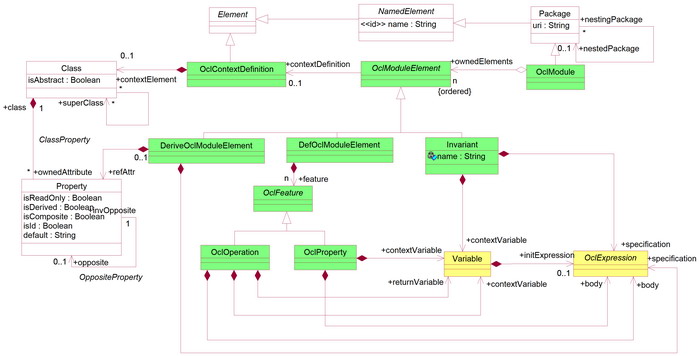
Figure 1. Elements
of the EnhancedOCL package in the OCL metamodel
SWRL is a web
rule language based on combination of the OWL
DL and OWL Lite sublanguages of the OWL Web Ontology
Language, with the Unary/Binary Datalog RuleML
sublanguages of the Rule Markup Language (RuleML).
SWRL is based on classical first order logic and
its rules are of the form of an implication between
an antecedent (body) and a consequent (head).
The intended meaning can be read as "whenever
the conditions specified in the antecedent hold,
then the conditions specified in the consequent
must also hold". Both the antecedent (body)
and consequent (head) consist of zero or more
atoms. Multiple atoms are connected with the conjuction
operator. Rule Definition Metamodel (RDM) is a
MOF-based meta-model for SWRL, and it is based
on [2] (see Figure 2).
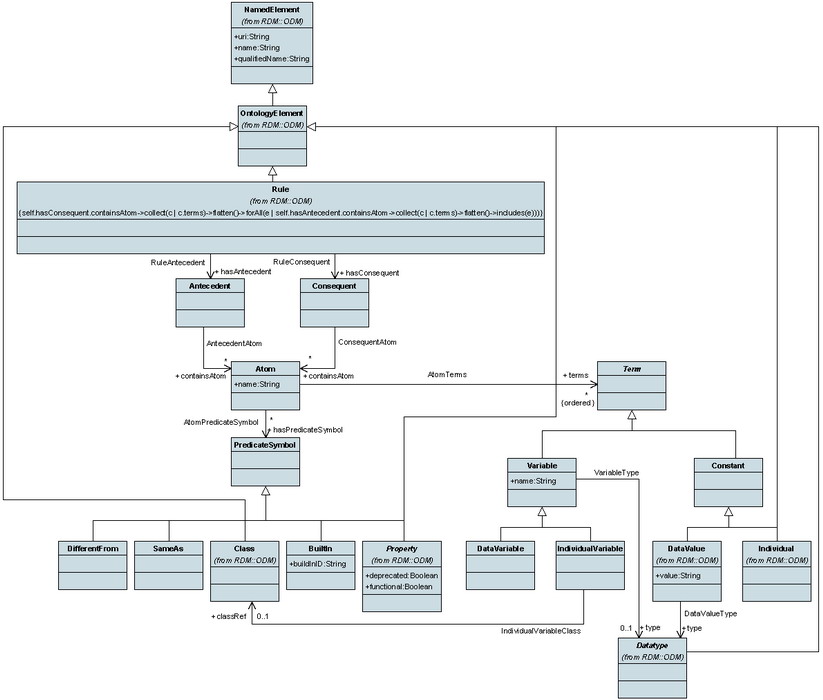
Figure 2. Main
elements of the Rule Definiton Meta-model (RDM)
R2ML represents
a general Web rule markup language that is defined
by a metamodel that is specified by using the
MOF metamodeling language, and it have also a
XML-based concrete syntax that is defined with
XML Schema. The R2ML metamodel [3] consists of
overlapping metamodels for the following types
of rules: integrity, derivation, reaction, and
production rules. Furthermore, the R2ML XML schema,
i.e., an R2ML concrete syntax, has been developed
for encoding rules by domain experts. Although
OCL can represent both integrity constraints and
derivation rules, we only describe R2ML integrity
rules here. An integrity rule, also known
as (integrity) constraint, consists of
a constraint assertion, which is a sentence in
a logical language such as first-order predicate
logic or OCL (see Figure 3). The R2ML framework
supports two kinds of integrity rules: the
alethic and deontic ones. An alethic
integrity rule can be expressed by a phrase, such
as “it is necessarily the case that”
and a deontic one can be expressed by phrases,
such as “it is obligatory that” or “it
should be the case that.”
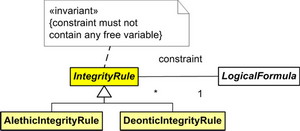
Figure 3. The
metamodel of integrity rules
Implemented solution of transforming
OCL invariants into the SWRL rules via R2ML rules
consists of five transformation steps. The first
one (see Figure 4) is between OCL rules (invariants)
represented in the OCL concrete syntax (in the
EBNF technical space) and models compliant with
the OCL metamodel (in the MOF technical space).
This is done by using the EBNF injection (ATL
feature) of OCL rules, that is, by instantiating
the MOF-based OCL metamodel (i.e., creating OCL
models) and by using the OCL parser we created.
Second, the MOF-based OCL rules obtained (OCL
models) are transformed to R2ML models compliant
with the R2ML metamodel. In the third step, R2ML
models are transformed into the RDM models (i.e.,
instances of the SWRL metamodel) by using R2ML2RDM.atl
transformation. In the fourth step, RDM models
are transformed into the XML models (i.e., instances
of the XML metamodel) by using transformations
RDM2XML.atl transformation.
Five, such XML models (from the
MOF technical space) are serialized into the SWRL
XML format (complaint with the SWRL XML Schema)
by using the ATL XML Extractor tool. All of these
transformations are based on the conceptual mappings
that we have defined.

Figure 4. The
transformation scenario between the OCL and SWRL
via R2ML
In addition, we have also defined
transformations in opposite direction, so it is
possible to translate SWRL rules into the OCL
invariants via R2ML (remark: this side have ceratin
constraints).
A UML model which contains a
UML class (Customer) and has an OCL invariant
defined on that class: if customer name is
'Jos senior' implies that is age is more than
21. is given in Figure 5. to serve as a running
example for this use case.

Figure 5. OCL
invariant and its corresponding UML class Customer
We first inject OCL code from
Figure 5. into the OCL model by using the EBNF
injector, (see Figure 4: EBNF injection), a part
of the ATL toolkit, and the OCL Lexer and Parser.
We generated the OCL Parser and Lexer by using
the TCS (Textual Concrete Syntax), i.e., by defining
TCS for the OCL. When we got an OCL model we then
transform OCL metamodel elements into the R2ML
metamodel elements (by using OCL2R2ML.atl transformations
from Figure 4). As a result we get the R2ML model
that can be serialized into the R2ML XML format
(see Figure 6.). More details about this serialization
process you can find in [4].
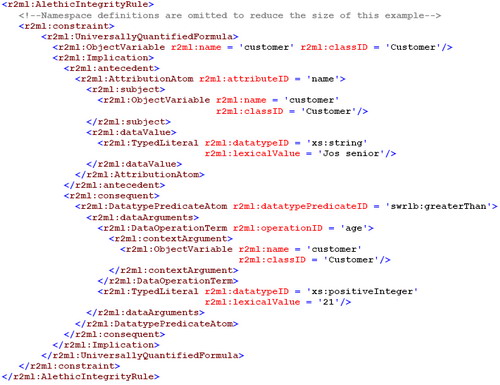
Figure 6. An
R2ML (alethic) integrity rule equivalent to the
OCL invariant from Figure 5
In the next step we transform
attained R2ML model into the RDM model (instance
of SWRL metamodel) by using R2ML2RDM.atl transformation
from Figure 4. Such RDM model can be serialized
in the SWRL XML concrete syntax. In order to serialize
the RDM model (from the MOF technical space) into
the SWRL XML concrete syntax (i.e., to the XML
technical space), we first need to use the RDM2XML.atl
transformation (see Figure 4) to get an XML model
from RDM model.
When we got a XML model which
conforms to the MOF-based XML metamodel we can
extract such model extraction from the MOF technical
space to the XML technical space (XML extraction
in Figure 4.) by using the XML extractor. A result
of this transformations process for the RDM model
attained in previous step is a SWRL rule in the
SWRL XML concrete syntax (see Figure 7).
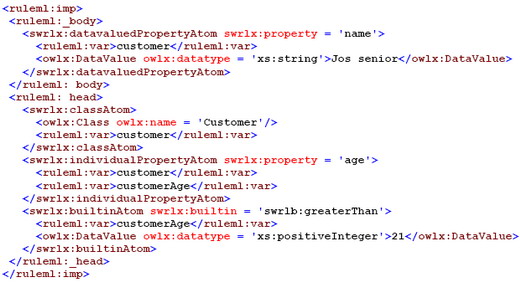
Figure 7. SWRL
rule of the transformed OCL invariant from Figure
5
This use case demonstrates how
the AMMA tools can be used to share rules between
different rule languages whose concrete syntaxes
are defined in different technical spaces (i.e.,
in the XML, MOF and EBNF technical spaces). This
ATL scenario provides a solution for bridging
SWRL/OWL and OCL/UML is based on the pivotal (R2ML)
metamodel that addresses the complexity of mappings
between two rule languages, which contain many
diverse concepts. More details about this scenario
you can find in [5]. |